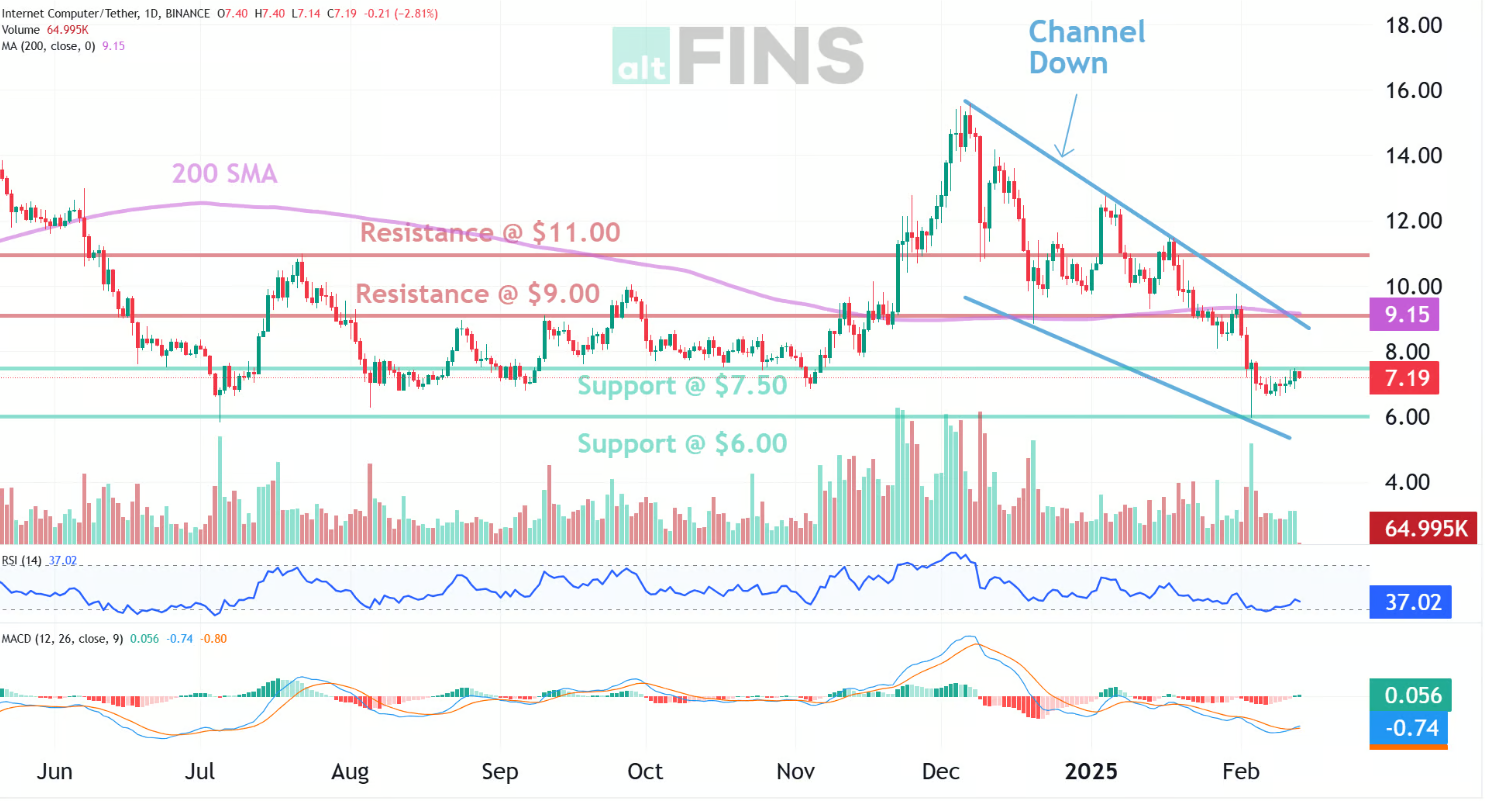ICP (ICP) Analysis
In addition to automated chart patterns, altFINS’ analysts conduct technical chart analyses of top 30 cryptocurrencies. We call these Curated Charts and they evaluate 5 core principals of technical analysis: Trend, Momentum, Patterns, Volume, Support and Resistance.
The Internet Computer (ICP) technical analysis:
Trade setup: Bearish breakout below $9.00 support and 200-day Moving Average (200 SMA) signaled onset of Downtrend. It’s now trading in a Channel Down pattern. We would consider Short Selling at $9.00 Channel Resistance. (Set a price alert) Learn to trade breakouts in Lesson 7 and Risk Management in Lesson 9.
Pattern: Price is trading in a Channel Down pattern. With emerging patterns, traders who believe the price is likely to remain within its channel can initiate trades when the price fluctuates within its channel trendlines. With complete patterns (i.e. a breakout) – initiate a trade when the price breaks through the channel’s trendlines, either on the upper or lower side. When this happens, the price can move rapidly in the direction of that breakout. Learn to trade chart patterns in Lesson 8.
Trend: Short-term trend is Down, Medium-term trend is Strong Down, Long-term trend is Down.
Momentum: Price is neither overbought nor oversold currently, based on RSI-14 levels (RSI > 30 and RSI < 70).
Support and Resistance: Nearest Support Zone is $6.00, then $6.00. Nearest Resistance Zone is $9.00, then $11.00.
See live The Internet Computer (ICP) chart here
See more curated charts of coins with technical analyses.

Recent news and research:
ICP Falls 3.2% as Index Trades Lower From Tuesday
The Best Coin to Invest in December 2024 Amid Solana’s NFT Growth and ICP’s Innovation
Find more real-time news here.
What is The Internet Computer (ICP)?
Find full description and news on altFINS platform.
Internet Computer (ICP) Overview
The Internet Computer (IC) is a decentralized blockchain network developed by the DFINITY Foundation to revolutionize how internet applications are built and used. It operates through a network of independent data centers running specialized hardware. Developers can create and deploy decentralized applications (dApps) using canisters, a form of smart contracts with a 4GB storage capacity. The IC utilizes two primary tokens: ICP and Cycles. ICP serves as the governance and utility token, while Cycles, created by burning ICP, are used to pay for computational resources.
History of Internet Computer
The Internet Computer project was founded by Dominic Williams under the DFINITY Foundation in October 2016. It aims to decentralize internet infrastructure to support a wide range of applications. DFINITY raised $121 million from notable investors, including Andreessen Horowitz, Polychain Capital, and Multicoin Capital. In 2018, the foundation distributed ICP tokens to over 50,000 participants through an airdrop. The IC launched its alpha mainnet on December 18, 2020, and made its public debut on May 10, 2021, unveiling its source code and the functionalities of the ICP token.
Technology
The Internet Computer extends public internet capabilities using its innovative Chain Key Technology. This technology integrates several advanced components:
- Consensus Model (Threshold Relay): A mechanism for achieving fast and secure consensus.
- Non-Interactive Distributed Key Generation (NI-DKG): A secure cryptographic method enabling decentralized key resharing.
- Network Nervous System (NNS): The on-chain governance system managing network operations.
- Internet Identity: A decentralized authentication system.
Chain Key Technology provides the IC with a single public key, enabling secure and efficient verification processes. It also supports network operations such as adding nodes, replacing faulty nodes, and upgrading protocols without downtime. The DFINITY R&D team developed a non-interactive key resharing protocol using advanced cryptographic techniques to ensure security and maintain key consistency throughout a subnet’s lifecycle.
ICP Token and Utility
ICP is the Internet Computer’s native token with three primary functions:
- Governance: ICP holders can stake tokens to create neurons, participate in governance decisions, and earn voting rewards.
- Computation: ICP can be converted into Cycles, which are burned to pay for computational operations, providing predictable costs.
- Network Rewards: The system mints new ICP to reward contributors such as node providers and governance participants.
The Internet Computer aims to redefine the internet by enabling scalable, secure, and decentralized application development, paving the way for a new era of Web3 innovation.